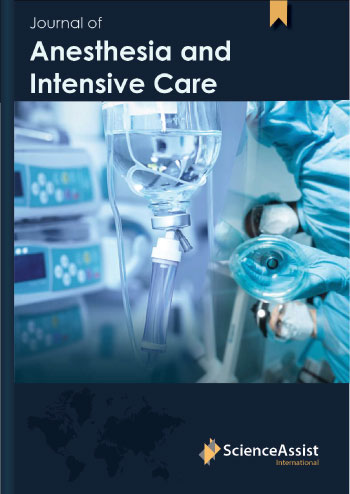
Volume 2, Issue 2 (2021)
INTRODUCTION
Association between the duration of sedation administration and that of mechanical ventilation (MV) has been reported and minimizing sedation among intensive care unit (ICU) patients provides clinical benefits [1-MATERIALS AND METHODS Study Setting This study was conducted at the ICU of Queen Elizabeth Hospital, which is a tertiary referring hospital in Hong Kong with 1972 acute beds. The ICU is a closed unit with 21 mixed medical and surgical beds with an annual admission of around 1100.
Study Design We conducted a ‘before and after’ protocol revision study with a series of measurements over time. Approval was obtained from the ethics committee to extract data for the 6 months before (1st September 2016 to 28th Feb February 2017) and the 6 months after (1st April 2017 to 30th September 2017) implementation of the revised sedation protocol.5]. A sedation weaning protocol was adopted in our ICU in 2010. We used the Richmond Agitation– Sedation Scale (RASS) [6] as an assessment tool and aimed for a range of −3 to 0. Spontaneous breathing trials (SBT) were attempted when patients were fit for liberation from MV. In 2016, we took the initiative to review the sedation practice as part of a larger project to reduce the ventilatorassociated pneumonia rate in the ICU. The revision of our protocol was based on the application of new knowledge on sedation management in ICU [2,3,5,7]. Changes were promulgated to doctors, and training sessions were organized for nurses, aiming to lighten sedation and allow quicker weaning from MV. The aim of this study was to evaluate the impact of the revised sedation weaning protocol on the duration of MV, consumption of sedatives and analgesic medications, length of stay, and the occurrence of any adverse outcome in the adult ICU.
Data Collection
Patients’ demographics, ideal body weight, primary disease category for ICU admission, APACHE II and IV scores, ICU length of stay (LOS), and outcome were collected. MV duration (defined as the time from first intubation to extubation or up to the time of tracheostomy) and daily consumption and duration of sedation and analgesia medication, as well as total dose and sedation-free period, were recorded. Use of alternative drugs for pain relief, medication for delirium, and RASS and CPOT scores were also recorded. Complications related to sedation weaning were recorded. These included self-extubation or removal of medical devices, unstable haemodynamics, ventilator dyssynchrony, agitation, and pain. The primary endpoint was the MV duration. Secondary endpoints included ICU LOS; consumption of sedation and analgesic medication; the percentage of time the target sedation range was achieved; and complication rate related to sedation/analgesia weaning. All data were extracted from patients’ computerized medical records (Philips IntelliSpace Critical Care and Anesthesia, ICCA) and the local clinical information system (CIS).
Statistical Analysis
Based on the findings from a previous study of a 30% reduction in MV duration [9], a power of 80%, 1:?1 sample size ratio, and alpha of 5%, the calculated sample size was 198. All analyses were performed using the Statistical Package for Social Sciences for Windows, version 20 (SPSS Inc., Chicago, IL). Means and standard deviations were reported for continuous variables and percentages and frequencies for categorical variables. Continuous variables were compared using a Student’s t-test while categorical variables were compared using Pearson chisquare tests or Fisher’s exact test as appropriate. All p-values are two-sided. Time to extubation was plotted using Kaplan–Meier survival analysis, and differences between groups were compared with the log-rank test.
1. Kress JP, Pohlman AS, O’Connor MF, Hall JB. Daily interruption of sedative infusions in critically ill patients undergoing mechanical ventilation. N Engl J Med. 2000;342(20):1471- 1477.
2. Strom T, Martinussen T, Toft P. A protocol of no sedation for critically ill patients receiving mechanical ventilation: a randomised trial. Lancet. 2010;375(9713):475-480.
3. Shehabi Y, Bellomo R, Reade MC, Bailey M, Bass F, Howe B, et al. Early goal-directed sedation versus standard sedation in mechanically ventilated critically ill patients: a pilot study*. Crit Care Med. 2013;41(8):1983-1991.
4. Reade MC, Finfer S. Sedation and delirium in the intensive care unit. N Engl J Med. 2014;370(5):444-454
5. Girard TD, Kress JP, Fuchs BD, Thomason JW, Schweickert WD, Pun BT, et al. Efficacy and safety of a paired sedation and ventilator weaning protocol for mechanically ventilated patients in intensive care (Awakening and Breathing Controlled trial): a randomised controlled trial. Lancet. 2008;371(9607):126-134.
6. Sessler CN, Gosnell MS, Grap MJ, Brophy GM, O’Neal P V., Keane KA, et al. The Richmond Agitation–Sedation Scale. Am J Respir Crit Care Med. 2002;166(10):1338-1344.
7. Barr J, Fraser GL, Puntillo K, Ely EW, Gélinas C, Dasta JF, et al. Clinical practice guidelines for the management of pain, agitation, and delirium in adult patients in the intensive care unit. Crit Care Med. 2013;41(1):263-306.
8. Gelinas C, Fillion L, Puntillo KA, Viens C, Fortier M. Validation of the critical-care pain observation tool in adult patients. Am J Crit Care. 2006;15(4):420-427.
9. Skrupky LP, Drewry AM, Wessman B, Field RR, Fagley RE, Varghese L, et al. Clinical effectiveness of a sedation protocol minimizing benzodiazepine infusions and favoring early dexmedetomidine: A before-after study. Crit Care. 2015;19(1):1-12.
